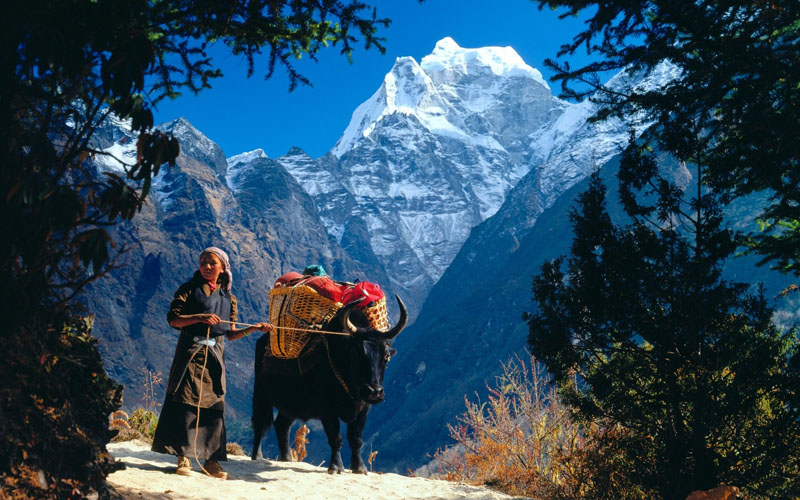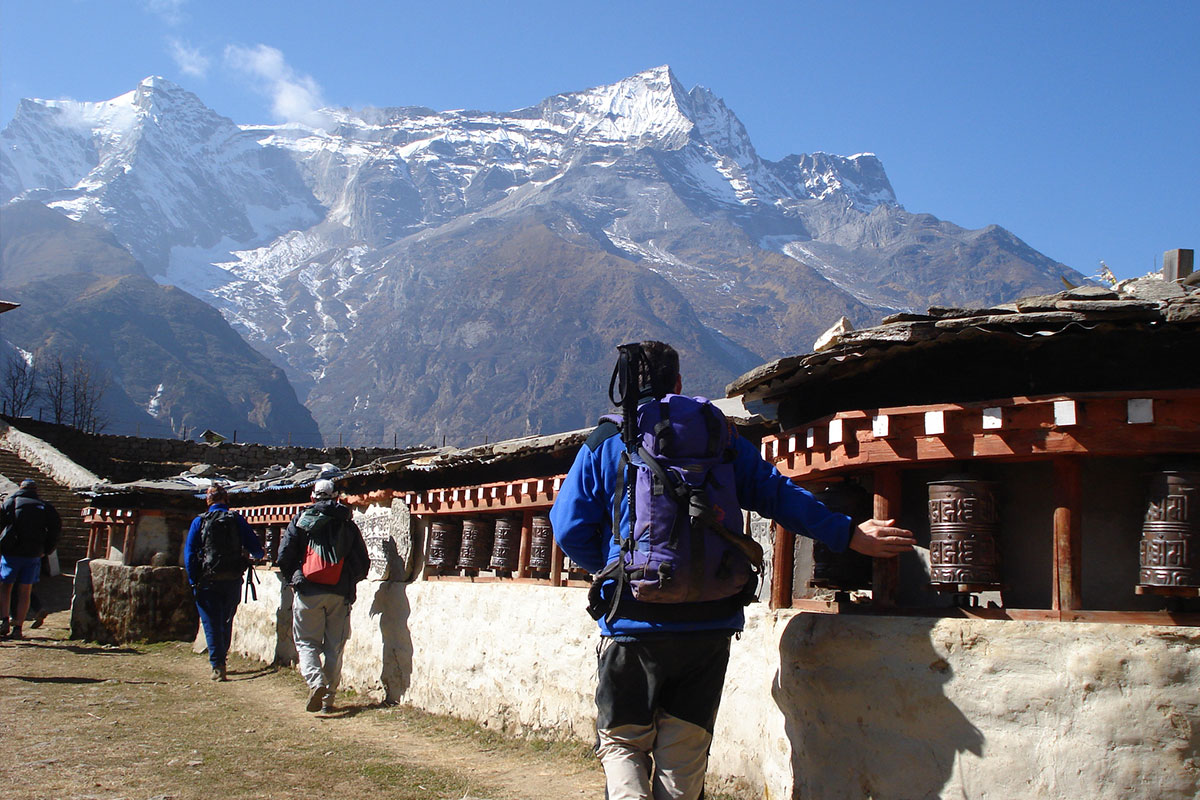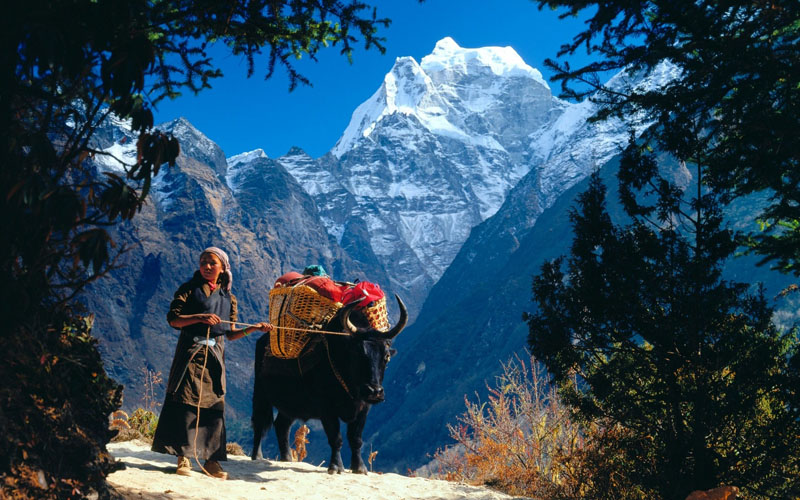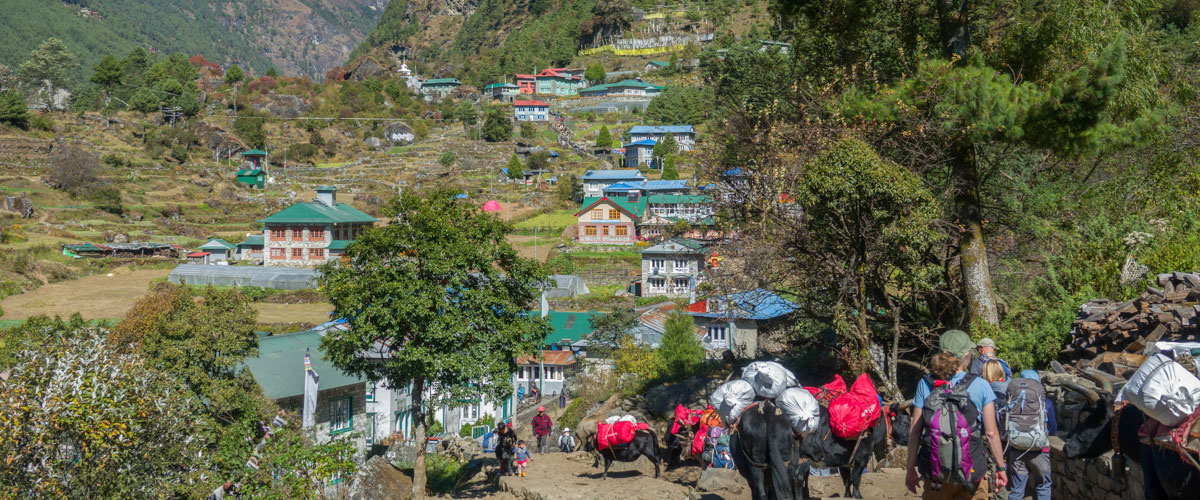Everest Cultural Trek
Trip Overview
Overview
The Everest Cultural Trek is an extraordinary journey that combines the breathtaking beauty of the Himalayas with the rich cultural heritage of the Sherpa people. This trek is also perfect for those seeking a unique adventure that goes beyond just mountain views, offering an immersive experience into the local way of life. The trek begins with a thrilling flight from Kathmandu to Lukla, a small mountain airstrip that serves as the gateway to the Everest region. From Lukla, the trail also winds through charming Sherpa villages, ancient monasteries, and lush valleys, providing a glimpse into the daily lives and traditions of the Sherpa community. One of the highlights of the Everest Cultural Trek is the visit to the legendary Namche Bazaar, a bustling market town and the unofficial capital of the Khumbu region. Here, trekkers can also explore colorful markets, interact with friendly locals, and learn about the Sherpa culture through traditional dances and music. As the journey continues, trekkers traverse through rhododendron forests, cross suspension bridges over roaring rivers, and pass through picturesque hamlets. Along the way, there are ample opportunities to interact with Sherpa families, visit monasteries, and gain insights into their spiritual beliefs and practices. Reaching Tengboche, trekkers are greeted by the magnificent Tengboche Monastery, the spiritual center of the region. The monastery offers breathtaking panoramic views of Everest, Ama Dablam, and other snow-capped peaks. This serene and tranquil setting provides the perfect opportunity for reflection and appreciation of the natural and cultural wonders of the Everest region. The Everest Cultural Trek concludes with a hike to Everest View Hotel, known for its stunning vistas of Mount Everest. This vantage point allows trekkers to savor the majesty of the world's highest peak up close, creating memories that last a lifetime.Conclusion and Summary
Overall, the Everest Cultural Trek is a remarkable adventure that combines the awe-inspiring beauty of the Himalayas with a deep immersion into the Sherpa culture. It is a journey that not only challenges your physical endurance but also nourishes your soul with the warmth and hospitality of the Sherpa people and the cultural riches of the Everest region.Trip Highlight
- Delightful short trek, which is one of the easiest options to visit the Everest region
- Short and scenic flight to Lukla’s challenging yet beautiful airport; Tenzing Hillary airport
- Glimpses of the world’s tallest peaks including Mt. Everest, Nuptse, Lhotse, Ama Dablam, Kusum Kanguru, and more
- Explore the lush natural environs of Sagarmatha National Park, also the highest national park in the world
- Have breakfast in one of the highest placed hotels in the world; Hotel Everest View
- Mesmerizing view of Mt. Everest and the surrounding Himalayas while having breakfast & chilling at the hotel
- Explore the stretch from Lukla to Phakding while crossing the epic & colorful Hillary suspension bridge
- Full exploration of Namche Bazaar, the center point for trekkers, and climbers
- Visit the historic Sherpa market and try the famous homemade yak cheese and butter
- Go to century-old monasteries like Tengboche (the largest monastery), Khumjung Monastery (with Yeti Scalp)
- Visit ethnic and unexplored villages like Thame, Khumjung, Monjo, Syangboche
- Explore the historic Khumjung Hillary School at Khumjung
- Celebrate the trip completion at one of the highest pubs in Namche
- Delve into the lifestyle and traditional and cultural celebration of local Sherpas
- Enjoy Wildlife Activities during Sagarmatha National park visit including Himalayan Tahr, Deer and Soon.
- Perfect for the one with limited travel and the beginner who haven’t walked higher elevations
Itinerary
Fly from Kathmandu to Lukla (2886m.) takes about 35 minutes. Trek from Lukla to Phakding (2640 m.) takes approximately three hours. You begin your trek from Lukla following a gentle climb up the mountainside on the left bank of the Dudh Koshi River. Nupla (5885m) which can be seen in the distance on the opposite bank is a peak atop the Kongde Ridge. You descend a mountainside path that merges into your route to Everest, with views to a valley to your right; and at its far end, Kusum Kang (6367m.) Stay overnight at lodge.
After your breakfast we’ll begin our sightseeing tour to the foremost historical and religious attractions in Kathmandu natural depression, together with Pashupatinath Temple, Kathmandu Durbar Square, Swayambunath (Monkey Temple) and Buddhanath Stupa, one in every of the big Stupas within the world, overnight at hotel.
After having breakfast, scenic fly from Kathmandu to Lukla. From Lukla the trail continues to Phakding that takes 3-4 hours, on the path unit Mani stone walls, factory-made from many stone tablets and massive graven boulders, brilliantly embellished with brightly-colored paints will seen. Throughout this era you may explore fabulous views of Mt Nupla(5885m), Kusum Kangaru(6367m) and thus the Mount Kwangde vary.
Today, the trail follows the Sherpa villages and splendid forests by crossing through the Dudh Koshi depression. Their ability to climb such hills with monumental tons is all technique, and following them permits you to be told the rhythm that produces every ascent appear straightforward. On the way, one can explore superb views of Kusum Kangru (6369m), Thamserku (6608m), Mount Everest (8848m) and Nuptse (7879 m). Overnight hotel in Namche.
Today you’ll be free in Namche Bazaar; an unimaginable village that’s that the commercial hub of the Khumbu. You’ll visit stunning market, Sherpa village and in the end fancy with the wonderful views of Mt. Everest, Mt. Ama Dablam, Mt. Thamserku, Mt. Nuptse, Mt. Lhotse, Mt. Kwangde and different many peaks.
Today is a pleasant and short day for the trek to Thame which is that the next gate for the people that to do the trade and Business. The trail goes up to the Nangpo Drangpo natural depression. You continue higher than the watercourse, the Bhote Khosi, on a contouring path through fine shrub forest. Thame is extremely standard for the climber as a coaching spots.
Today our trail goes through downhill to the Bhote Kosi natural depression towards Namche and branch off to follow a quiet path to Khumjung. Khumjung is a charming village that conjointly has its own gompa at the highest finish of city by offering wonderful views of Thamserku, Kantega and Ama Dablam.
Today goes through passing the little settlement of Sanasa from wherever the path drops towards Phunki Thanga (3250m). Then the path climbs steeply up through forests and around Mani stones because it follows the aspect of a hill to the saddle on which the monastery of Tengboche. The views from here are one among the worlds most opulent.
In the morning you will visit to the Tyangboche monastery and the nearby museum. In the afternoon you retrace your steps downhill through the beautiful forest of juniper, rhododendron and fir to Phunkitenga. After you cross the Dudh Koshi, you ascend steeply to Trashinga. From here the trail contours high above the valley to Shanasa. The villages of Kunde and Khumjung are only a short trek off the main trail and are well- worth visiting. Khumjung has a beautiful monastery and Kunde has a small hospital run by late Sir Edmund Hillary’s Himalayan Trust and you will return to Namche via this route. The walk also heads past the Everest View Hotel and the Syangboche airstrip before dropping into Namche where you take lunch. In the afternoon you descend steeply and then walk along the river bank back to Jorsale where you leave the national park before continuing to Monjo.Stay overnight at lodge.
You re-trace your steps along the Dudh Koshi, crossing the western bank at Benkar. It is a beautiful and easy walk through blue pine and rhododendron forest, back-dropped with views of Kusum Kangaru. An early lunch at Phakding and in the afternoon you ascend out of the river valley back to the airstrip. In the evening, a farewell dinner may be followed by a few celebratory drinks and dancing with Sherpa companions. Stay overnight at lodge.
This is the last of your trek; after having breakfast, you will be flying back to Kathmandu. The 40-minute flight back to Kathmandu will indeed be a relaxing one. It will provide you some time to appreciate your achievement and fall back on your memories. After arriving in Kathmandu, we will head to our hotels respectively. How you spend the rest of the day is entirely up to you.
Accommodation: at a 3 star Hotel
Meals: Breakfast
Place: Kathmandu
Maximum Altitude: 1400M
Friendship World Treks will be organizing a farewell dinner on this day. You will also be receiving successful trek certificates. It would also serve as an opportunity to let Friendship World Treks know what you loved about the trek, what you hated, and how the experience could have been richer.
On your final day in Nepal, a representative of Friendship World Treks will transfer you to Tribhuvan International Airport for your final departure. Your pick-up time from the hotel will depend on when your flight is scheduled to depart so be sure to make note of the time and be prepared to leave.
Departures & Availability
The set departure dates listed are specially quoted and specified for group joining option. Let us know if the set departure dates are not suitable for you- another dates which are suitable for you can certainly be added by us.
Check Available Dates
| Start Date | Price | Availability |
|---|
All trip prices are per person based on double occupancy, are subject to change without notice and do not include airfare. All prices and fares are quoted in U.S. dollars.
Price include
- All airport pick-up and drop-off services by private car
- Trekking guide
- Porters (1 porter for each 2 participants to carry 25 kilograms of luggage)
- All meals three times a day (breakfast, lunch & dinner) including fresh fruits, 3 times tea/coffee every day and drinking water
- Accommodation in lodges during the trek
- Sleeping bags, down jackets, duffle bags and trekking sticks if required
- Entry permit for Sagarmatha National Park
- Trekkers’ Information Management System (TIMS) card
- Flight ticket from Kathmandu to Lukla and Lukla to Kathmandu
- Insurance and equipments for the guide and porters
- First aid kit
- Rescue assistance (Should any emergency arise during your trek, we will provide prompt and professional rescue and medical services. For this, it would be better to have your own travel insurance that can cover helicopter evacuation and medical treatment cost incase required.)
- One farewell dinner in Kathmandu with live cultural performance at authentic Nepali restaurant on the last evening
- Souvenir (t-shirt, mug, pen, bag, etc.)
Price Excludes
- Personal nature expenses
- Drinks, beverages, hot shower, etc.
- Travel insurance
- Tips
- Entrance fees while sightseeing
- Meals & hotel accommodation in Kathmandu
Gears And Equipment
Trip Information
Best Time to Visit Everest Cultural Trek
To know when is the best time to visit the Everest region for the Everest Cultural Trek, let’s understand what the weather is like there during the four seasons.
- i) Spring (March to May): Spring is one of the favorite times to be in Khumbu. The weather is moderate, crispy, and clear most of the time. The average daytime temperature is 15℃and nighttime is-1℃. The wind speed is stable as well with 11km/h. And there are fewer chances of heavy rainfall.
Thus, the conditions are favorable for trekking, making it the best time to visit. The sky is clear, with few clouds, so the scenery is at its best with no obstructions. Also, the season is the best to witness the blooming floral varieties within the national park. The environment is simply amazing and serene. Almost all the places/routes, guesthouses are open. So, you’ll have a comfortable stay and meet many fellow trekkers on the way.
- ii) Autumn (late September to November):It’s another great time for Everest Cultural Trek. The temperatures are moderate with the average daytime temperature of 17℃and at nighttime -8℃. The precipitation rate is the lowest as well but there are chances of slight snowfalls towards the end of the season.
Besides the weather, the season will give the most incredible views of the mountains. Also, the landscapes are lush and verdant as never before. However, it’s the pre-winter season so the winds are strong and cold. The average rate is about 22km/h. Hence, make sure to wear a windproof down jacket.
iii) Monsoon Season (June to August): The Everest region sees heavy rainfalls even in the higher altitudes. The average precipitation rate is 170mm per month. Also, the temperature fluctuates with the average day temperature being 22℃ and 4℃ at nighttime. Due to higher rainfall, the routes are muddy and become challenging to traverse.
In such cases, you can rather opt for other options like Helicopter Tour or Mountain Flight to Everest.
- iv) Winter (December to February):It’s the coldest time of the year in the Everest region. The average daytime temperature is -5℃and at night it can drop down to -15℃. There are less chances of rainfall and heavy winds. But, there are high chances of snowfall all over the region.
Despite the chilly weather, this season brings sunshine with clear skies. This makes the visit worthwhile as you get to explore the unexplored. You can opt to go there early in winter. That way, you get to own the place by yourself as there will be fewer visitors and the teahouses offer handsome discounts too.
Overall, looking at the situations of every season, we can say that Everest Cultural Trek is possible at any time of the year. However, spring and autumn are the best times to get favorable experiences. Having said that, if you make the right packing & preparation, you can explore more during other seasons as well.
We (Friendship World Trek) are open for Everest Cultural Trek at any time of the trek. Do let us know the feasible time for you and we’ll manage the rest without compromising your safety & comfort!
Permits Required for Everest Cultural Trek
You will need two major permits and no TIMS card for Everest Cultural Trek. Yes, you don’t need the TIMS card for the Everest region anymore. According to the new permit system, you will only need two permits: Khumbu Pasang Lhamu Rural Municipality Entrance Permit and Sagarmatha National Park Entry Permit.
You need to collect the Khumbu Pasang Lhamu permits from the local government of Khumbu directly. You can’t obtain it in Kathmandu. It’s available in places like Lukla and Monjo village (if you’re traveling from Jiri or Salleri).
Regarding the Sagarmatha National Park permit, it’s available in Kathmandu too. You can obtain it either from Nepal Tourism Board, Kathmandu, or at Park Entrance, Monjo.
Additionally, if you choose to take the route from Salleru instead of Lukla, you’ll need another permit. It’s Gaurishankar Conservation Area permit. You can simply get it from NTB, Kathmandu. The office is unavailable on Saturday and local holidays. It’s a thing to remember if you’re arranging the permits by yourself.
However, if you’re traveling with us, you don’t have to worry about them at all. As a fully registered travel company in Nepal, Friendship World will handle & arrange them for you.
Just make sure you carry every necessary document like the original passport and its copies, visa copies, passport size photos, and copies of your travel insurance.
Visa Information: You can obtain a visa easily upon your arrival at Immigration Office at Tribhuvan International Airport. There, you will need two copies of your passport size photos. The procedure for an ‘On Arrival’ visa is quick & easy. The cost of the tourist visa with Multiple Entries for 30 days is USD 50 or equivalent foreign currency. Similarly, a tourist visa with Multiple Entries for 90 days costs USD 125. Likewise, you can also apply for a visa via an online application and payment.
How is Food and Accommodation in Everest Cultural Trek?
The food and accommodation in Everest Panorama have multiple options from basic to luxurious. You can choose the type of service you want and enjoy your trek to the fullest. Friendship World Trek makes sure to provide the best food & accommodation services for an enjoyable experience. For now, let’s get into the details!
Accommodation in Everest Cultural Trek
- I) Teahouse Trekking:Everest Trekking region is the most popular choice for trekkers. Due to the popularity, there are plenty of standard teahouses and lodgeson the trek. The teahouses are warm, comfortable, and provide all the basic services.
They have rooms with twin beds for two people. There will be a common toilet for all but some lodges do offer rooms with attached bathrooms. Thus, you can upgrade to it if you want to. About the bed in the rooms, they have pillows, mattresses, and blankets.
Besides the bedrooms, every teahouse has a big living room alongside the kitchen, where you can eat and relax. This is also the place where you can socialize and meet with other trekkers.
Regarding extra services, WiFi is available everywhere in Khumbu, especially in lower altitudes. The lodges also provide charging services but they will charge on a per hour basis. Similarly, you’ll need to pay extra for hot showers, boiled water, and miscellaneous services.
About the toilets in the teahouses, they vary as per the trail you’re in. In the lower altitude, they have western-style flush toilets. But as you go higher, most of them will have clean squat toilets. It’s advisable to carry toilet paper.
So, this was the case for the type of teahouse trekking for Everest Cultural Trek. If you wish we can arrange another type of accommodation for this trek. It includes Camping Trek and Hotel/Lodge Trek.
- II) Camping Trek:In this type of trek, you will reside on a tented camp throughout your journey. It will need a good crew of experienced guides & porters. It can be a little challenging but it will give you a thrilling experience. If you wish for such an adventure, we can arrange camping accommodation for Everest Panorama as well.
III) Luxury Trek: In this type of trek, you will reside in a luxurious hotel and lodges found in the trail. It will cost you more, but if you have the budget you can go for it. Here, you will get more comfortable rooms with attached bathrooms, hot showers, electric blankets, charging plots, wi-fi, and more. Besides the deluxe rooms, you will get a variety of national & international cuisines.
Food in Everest Cultural Trek
In the Everest Cultural Trek, we ensure that you have food of good quality. The food might be basic but they will be fresh, nutritious, and sufficient for you to walk for miles. The most popular food on the trek is dal bhat i.e. boiled rice with lentil soup and seasonal vegetables. You can opt for a non-veg set here. It’s the best choice you can eat as much as you want and is fully nutritious. There is a popular saying ‘Dal Bhat = Unlimited Power’. You can have it either as your lunch/dinner or both.
The teahouses provide a wide range of western meals too. Let’s look at the options available for Breakfast, Dinner/Lunch, and Desserts:
Breakfast: Boiled/fried eggs, omelets, boiled/fried noodles, french toast, porridge, oats/muesli, tea, coffee, hot chocolate, etc
Lunch/Dinner: Variety of soups (mushrooms, chicken, garlic, seasonal vegetables), Dal Bhat, Macaroni, spring rolls (chicken, veg, mixed, cheese), fried potatoes, meat steak, pizza (cheese, meat), lasagna, and more depending on the teahouses.
Desserts: fruit pie, chocolate cake, rice pudding, chocolate pancakes, chocolate bars, etc.
Your breakfast will be ready by 7 or 8 am in the morning. You’ll have it in the same teahouse you stayed at the other night. Likewise, you will have your lunch on the way. Regarding the snacks, you can carry stuff like snickers, cookies, fruits, etc to eat midway.
Drinking water in Everest Cultural Trek: We highly suggest you carry your own reusable bottles. You can refill your bottles from the teahouses where you stay. Also, you can order boiled water at an extra cost. If needed, we can refill the drinking water on the way as well. You don’t have to worry much, we will take care of everything you need.
How Difficult is Everest Cultural Trek?
Everest Cultural Trek is one of the popular short treks in the Everest region of Nepal. It will take you to amazing places like Lukla, Hotel Everest View, Namche Bazaar, Khumjung, and Tengboche. The best part is you get to explore the best without even troubling much. Since all the destinations are below 4000m, the trek is safe in terms of altitude too.
Keeping all these points in mind, the Everest Cultural Trek is of moderate grade. You don’t need any technical training or climbing experience. Even if you’re a beginner, you can go for this trek.
But having said that, you must have to do some level of training. After all, you will be walking over 3000 meters and the trails aren’t straight. You will often be climbing many steep uphills, so your core strength & endurance really counts.
Here are some of the basic training ideas you can do for Everest Cultural Trek. You can start the prep 4-6 weeks prior to your trek.
- i) Physical Training:You don’t need intense strength training for this trek. Simply, you can focus on the exercises that would improve your core strength and endurance. For that, you can start by walking on the treadmill. Further, you can do squats, lunges, and do some light lifting to strengthen your legs. Further, aerobic trainingis helpful to improve your cardiovascular fitness. Thus, don’t forget to go running, jogging, rowing, and swimming.
- ii) Altitude Conditioning: Walking on higher altitudes isn’t easy. Especially, when the paths are full of narrow ups & downs, the journey gets tougher. Thus, it’s better to prepare your body for such altitudes. You can do that by hiking to higher altitudes. Start with normal heights and you can increase the rate gradually. While you do that make sure you carry some loads and wear comfortable gear. It’ll give you a true feeling of the trek you’re going to.
iii) Mental Training and Nutritional Diet: You can’t ignore your mental health while traveling. You need to have a good mental state as it’ll add more energy and preparedness. For proper mental training, you can do meditation and yoga. You can also be involved in other activities that ensure safe & sound mental health.
And as you head to such training, make sure you aren’t ignoring your diet too. You need to intake the necessary amount of calories. Also, they should be rich in protein and minerals. Make a balanced diet routine and follow it and make sure it has a lot of green vegetables, meat, fruits, milk, curd, and so on.
Flight and Travel Information For Everest Cultural Trek
Everest Cultural Trek starts with a scenic flight to Tenzing-Hillary Airport in Lukla. And it is the most challenging airport due to its high altitude and short runway. Despite all the challenges, the experience is once in a lifetime and you’ll enjoy it thoroughly.
The flight you take to Lukla will be on a small flight. The spaces in between the seats are narrow as well. The seats will depend on the airlines you’re traveling by. But, the flight gives you the best view of the Himalayas.
Right after you take off, the awesome view of Kathmandu valley will welcome you. The surrounding hills and Himalayas like Gaurishanker, Ganesh appear incredible. As it reaches the Everest region, the scenery becomes more magical.
If you want to avoid flights, you have two other options. You can either charter a helicopter or take the route from Salleri. The cost of chartering a helicopter to Lukla is USD 500 per person. So, it might affect the budget you planned before. Whereas, to reach Salleri, you’ll have to take a long drive alongside the Sunkoshi river and valleys like Okhaldhunga. You’ll travel for about 12 hours to get there.
Further, you’ll trek through Takshindo, Kharikhola, and Paiya to reach Phakding. From Phakding, the trek route follows the usual path to Namche. Thus, this option might be free from the risk of flight but will take some more days.
Everest Cultural Trek Route Map
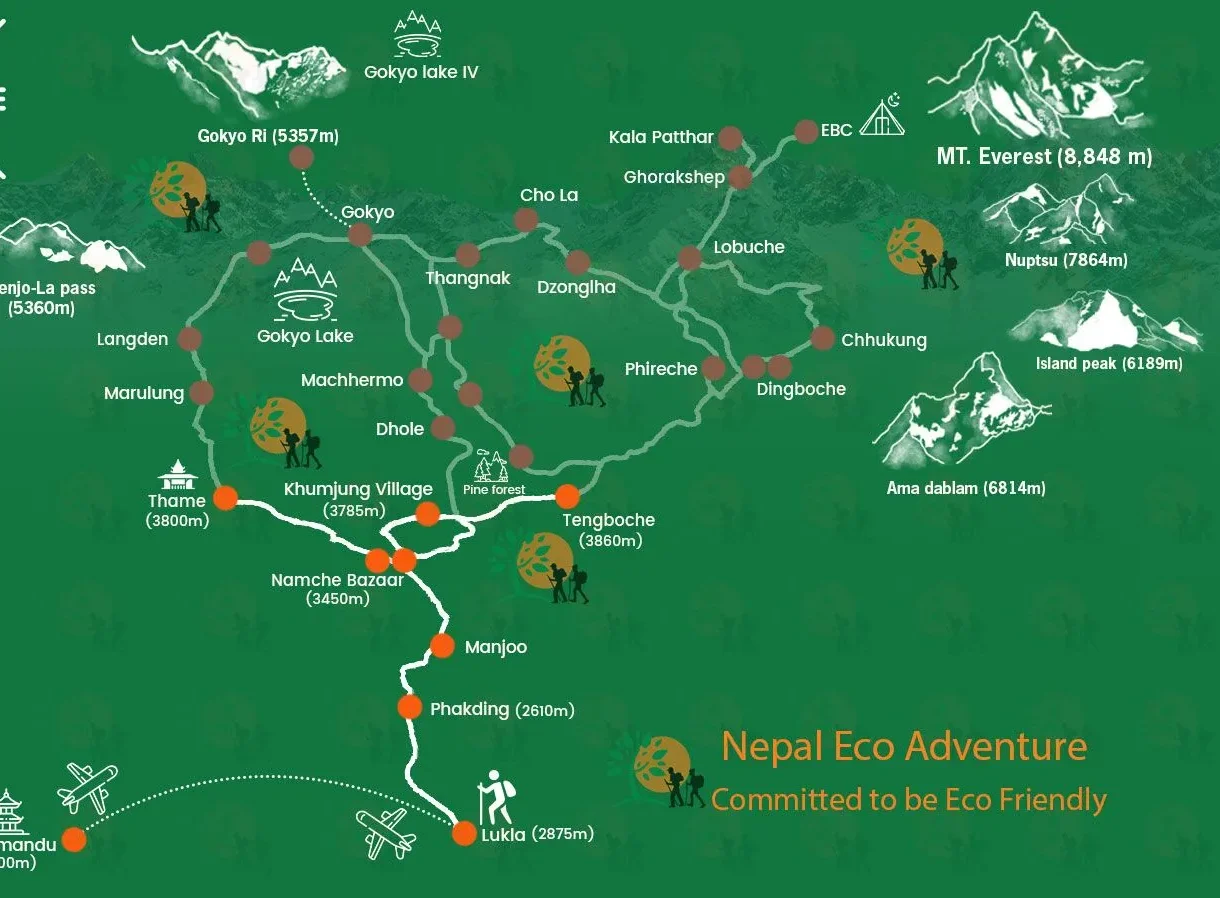
FAQS
Lorem Ipsum is simply dummy text of the printing and typesetting industry. Lorem Ipsum has been the industry’s standard dummy text ever since the 1500s, when an unknown printer took a galley of type and scrambled it to make a type specimen book. It has survived not only five centuries, but also the leap into electronic typesetting, remaining essentially unchanged. It was popularised in the 1960s with the release of Letraset sheets containing Lorem Ipsum passages, and more recently with desktop publishing software like Aldus PageMaker including versions of Lorem Ipsum.
Lorem Ipsum is simply dummy text of the printing and typesetting industry. Lorem Ipsum has been the industry’s standard dummy text ever since the 1500s, when an unknown printer took a galley of type and scrambled it to make a type specimen book. It has survived not only five centuries, but also the leap into electronic typesetting, remaining essentially unchanged. It was popularised in the 1960s with the release of Letraset sheets containing Lorem Ipsum passages, and more recently with desktop publishing software like Aldus PageMaker including versions of Lorem Ipsum.
Traveler Reviews
These full and frank reviews are from travelers who have traveled with Ace the Himalaya previously. The reviews and experiences shown here are from reputable travel websites like TripAdvisor, Google, Facebook, and Trust Pilot, etc.
